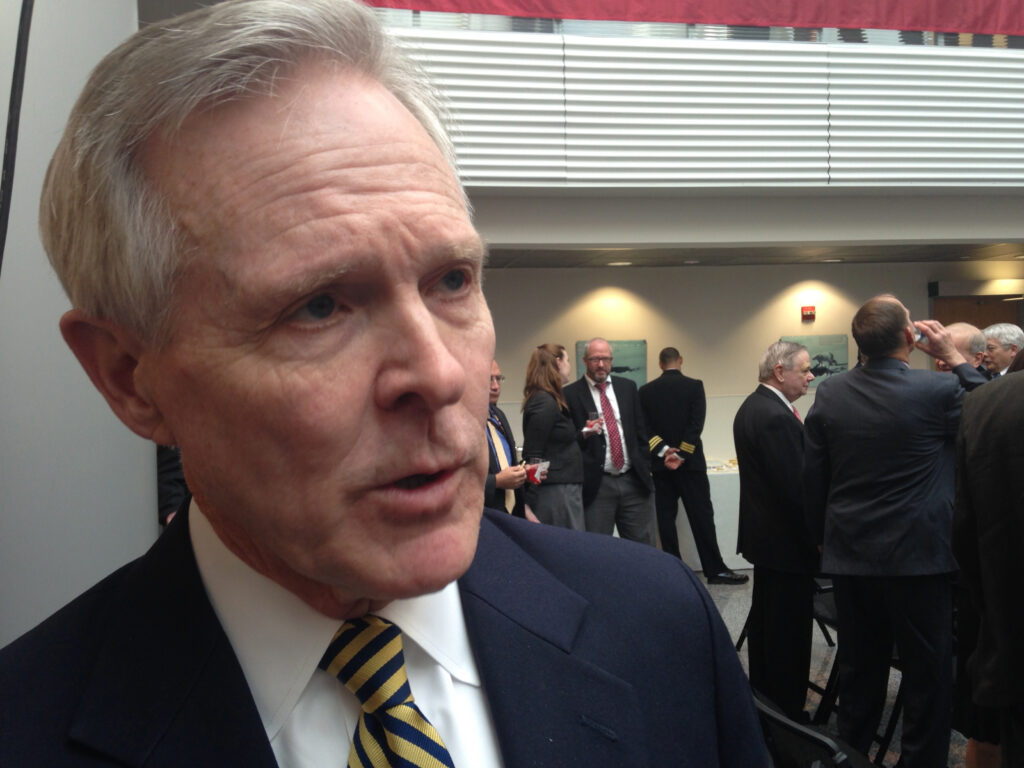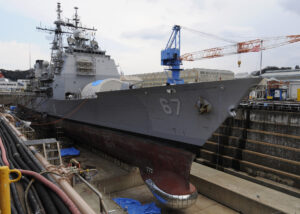Mabus To HASC: Your Cruiser Plan Will Cost ‘100s Of Millions’ More
Posted on

Navy Secretary Ray Mabus
NATIONAL PRESS CLUB: Congress doesn’t trust the Navy to keep its aging cruisers in service, Sec. Ray Mabus acknowledged this afternoon. But they don’t have to trust anybody: They make the law.
Let Congress pass whatever law it likes compelling the Navy to keep and modernize the ships, Mabus told reporters here. “I’m willing to accept any sort of mandatory language that says we’ve got to do this,” he said. “Mandate us to buy all the modernization stuff — with the exception of electronics because that’s going to change so much — up front. Mandate that we sign contracts with the shipyard that would cost us money if we backed out of ’em. There are ways you can do this.”
But — and this is a big but — whatever you do, just don’t make us modernize the cruisers at the accelerated pace that the House Armed Services Committee voted for yesterday. The Navy can’t afford it: “If it’s done under the congressional plan, the one that’s being put forward now, we’re not going to have enough money,” Mabus said.

A Navy Aegis cruiser in drydock for a maintenance “availability.”
Taking a cruiser out of service for four years, as in current law, lets the shipyards schedule the work efficiently and lets the Navy dissolve the crew, thus saving personnel costs. Taking a cruiser out for only two years, as the HASC bill would require, means the shipyard work costs more and the crew has to stay on the payroll. As a result, the special fund set aside for cruiser modernization will run out sooner, in 2018, and “we’ll just have to come back” and ask for more money for the rest of the ships, Mabus said.
How much more, a reporter asked after his speech? Hundreds of millions? “More,” said Mabus.
Mabus doesn’t have a problem with most of the provisions in the HASC mark-up of the National Defense Authorization Act for 2016. “Overall,” he said, “[in] the Navy and Marine Corps, we’re relatively, relatively happy about the mark. In terms of the cruisers, I really do think it’s a matter of just not quite trusting us.”
“Not quite” is quite an understatement, at least when it comes to some House members. “The question is whether we just let the Navy run the clock out and leave these cruisers up on the dock where we never use them again,” fumed the HASC seapower subcommittee chairman, Rep. Randy Forbes, at yesterday’s markup. “If you pass this language, two years from now, we’ll have a couple of modernized cruisers,” he said, arguing for the accelerated modernization plan. If the Navy’s allowed to take longer, Forbes said, it’ll slow-roll Congress and do nothing: “Several years from now,” Forbes said, “the Navy’s going to tell you, ‘we’re sorry, we can’t do the modernization.'”
“If you’re going to do any kind of program the Navy is serious about, they’re would have had put money in their Future Years Defense Program [FYDP],” Forbes said. For cruiser modernization, he said, “they not only haven’t put a dime in, they’re not going to do it.”
“None of those things is correct,” Mabus said mildly. He and the Chief of Naval Operations, Adm. Jonathan Greenert, are “100 percent” committed to modernizing the cruisers, he said. “Now, three or four years ago, [that was] not the case,” Mabus acknowledged. “We did put in a budget that had some cruisers decommissioned,” he said, adding with a chuckle, “That was not my idea.”
The Navy’s current plan does not decommission any cruisers, Mabus hammered home. “They will still be under the command of the CNO, they will never go out of commission, and if we needed to put ’em back to sea — except for the ones in deep modernization — we could. We would just get a crew on ’em and take ’em out.”
(Mabus seems awfully optimistic here about the Navy’s ability to put a crew together on short notice. Imagine how hard it is to get a pick-up basketball team together. Then imagine that team has 330 members who must operate everything from 2,500-horsepower turbines to Tomahawk cruise missiles).
What about the FYDP? Why hasn’t the Navy allocated funding for cruiser modernization in the outyears? “It’s because of the — what’s the name of that fund?” Forbes said. “SMOSF, whatever that means.” (It means “Ship Modernization, Operations and Sustainment Fund,” and SMOSF is pronounced to rhyme with “Joseph”). As a special fund, SMOSF doesn’t show up in the FYDP the way a normal program would. It’s also going to run out ahead of schedule if Congress accelerates the modernization.
“We thought we came up with the best way to keep the most cruisers in for the longest time in the most affordable way, but obviously they get the last word,” said Mabus.
Subscribe to our newsletter
Promotions, new products and sales. Directly to your inbox.
